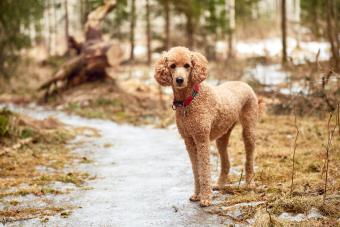
Once used mostly in hospitals and clinics, therapy dogs are becoming increasingly popular for individual use by those with autism spectrum disorder (ASD). These animas help work on a variety of therapy goals, from providing reassurance during stressful transitions to helping teach and reinforce social skills. Certain breeds are especially great when it comes to ASD.
Small Breeds - Ideal for Small Spaces
There are some reasons you may want to select a small breed as a therapy dog. For older adults or those with other disabilities, small dogs can snuggle easily in a bed or wheelchair. They are also good for those with limited space, since they don't take up as much room in an apartment or smaller home.
Toy or Miniature Poodle
Because of their intelligence and good nature, poodles are easy to train as therapy dogs. Animal Planet reports they are the most popular choice for school therapy use, which makes them an excellent choice for kids with ASD. Toys are small enough to fit on a lap in a wheelchair, and miniatures are just the right size to be held on the lap. This breed is also hypoallergenic, making it ideal for those with allergies.

Corgi
Because the Corgi is a herding breed, it has the added advantage of being able to alert caregivers to wandering, a common concern with children and adults on the autism spectrum. Corgis are also especially well-suited to therapy because of their calm demeanor and tolerance for the unexpected.

King Charles Spaniel
Obedient, warm, and social, King Charles spaniels are good with change and unexpected movements. These are a few of the qualities that makes them ideal therapy dogs for people on the spectrum. Their small size is perfect for snuggling, and people with ASD report that they are wonderful because they can be trained not to jump or bark.

Medium Breeds - Great for Kids
If you have more space, a medium-sized dog can make a wonderful therapy companion. These dogs are the perfect size to enjoy playing and snuggling with kids, but they don't take up too much room. They are too large to be comfortable lap dogs, so they are not ideal for people with ASD who also have mobility issues.
Viszla
The viszla is not commonly thought of as a service or therapy dog. However, according to My Assistance Dog magazine, there's a lot about this breed that makes it ideal for someone with ASD. Viszlas are known for their strong bonding ability, especially with one or two special people. They are also excellent at grooming themselves, dealing with strangers and unexpected situations, and handling changes in environment. They do, however, require lots of exercise, so that's a consideration if you don't have time to regularly walk them.

Standard Poodle
There are several organizations that specifically train standard poodles as therapy or service dogs for autism, including American Poodles at Work (APAW). The poodle's intelligence, hypoallergenic coat, and steady temperament make it ideal for this kind of role. APAW recommends getting the poodle when it is between six and 12 months old, so it can be young enough to accept sudden changes and unexpected behaviors as part of its regular life.

Large Breeds - Well-Suited for Deep Pressure
According to Autism Speaks, many large breeds work well as therapy or service dogs because of their calming influence. These big dogs can lie next to or even on a child or adult who needs deep pressure for sensory challenges, and they respond well to family life. Paws with a Cause specifically recommends two breeds.
Golden Retriever
One of the most popular dog breeds in America, the golden retriever has several characteristics that make it work well as a therapy dog. The kind, friendly nature of the breed helps it bond socially with people on the spectrum, and when trained well, it obedient and eager to please. This breed does require regular exercise, but walking the dog can make a good social activity for the family.

Labrador Retriever
Autism Service Dogs of America also recommends Labrador retrievers as therapy dogs for people with ASD. When well trained, their exceptional social skills give them an advantage with kids and adults on the autism spectrum. The number one most popular dog breed in the US, labs are strong and sturdy, play well, and with enough exercise, can be calm and steady.

Introduce the Therapy Dog Slowly
No matter which dog breed you choose, take some time to introduce the dog slowly to your home or clinic. Adults and children with ASD may not immediately warm up to the dog. A period of introduction and ice-breaking can help create a strong bond that can provide reassurance and social stimulation.







